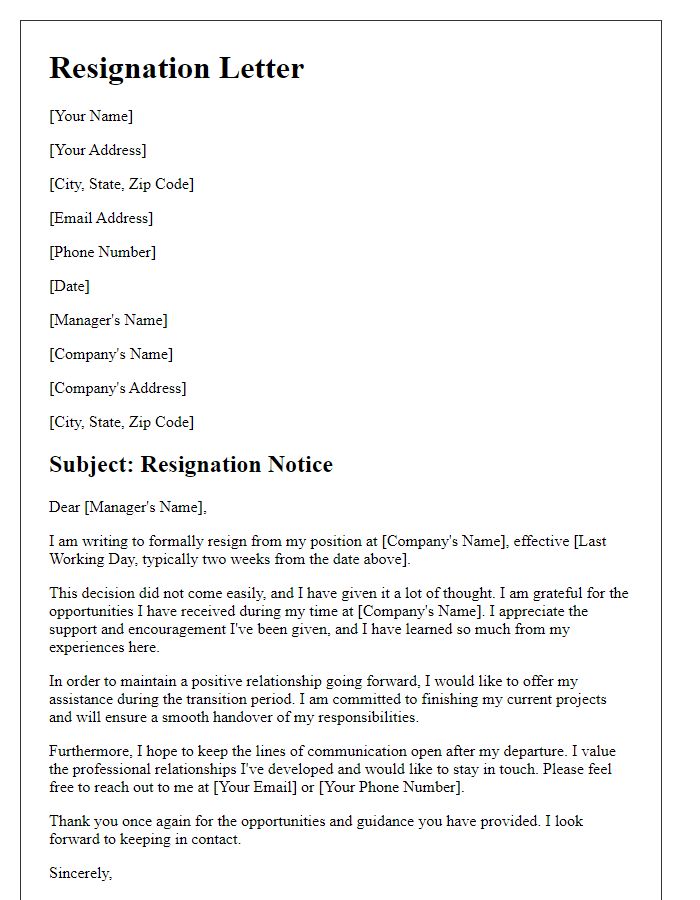Are you considering making a big career change and need to resign from your current position? It's important to approach your resignation thoughtfully, especially if you're looking to maintain a positive relationship for potential future opportunities. In this article, we'll discuss how to craft a resignation letter that not only communicates your decision but also outlines any conditions for a possible return to the company in the future. So, let's dive in and explore the best ways to leave your job while keeping doors open!

Clear statement of resignation
Resignation signifies a formal decision to quit a job position. The process involves stating intentions clearly, ensuring both parties understand future employment conditions. Notice periods typically range from two weeks to a month depending on company policy and contracts. Providing reasons for leaving, such as pursuing new opportunities or personal development, can enhance professionalism. Maintaining a positive tone ensures future references remain beneficial. It is essential to express gratitude toward colleagues, highlighting positive experiences during tenure. Documenting conditions for possible re-employment can facilitate open communication about future career opportunities, preserving professional relationships.
Specific end date of employment
Resigning from a position requires careful consideration and clear communication. Providing a specific end date for employment, such as November 30, 2023, is crucial for both the employer and the employee to prepare for a transition. Stating conditions for future employment, such as the possibility of returning in a different capacity or obtaining a positive reference, helps to maintain a professional relationship. Including appreciation for the opportunities received during the tenure emphasizes respect and gratitude toward the employer, enhancing prospects for favorable future interactions.
Conditions for future employment or rehire
Resignation from a position can be a pivotal moment in one's career journey, especially when outlining conditions for future employment or rehire. Clear communication on intentions is crucial. Including specific criteria such as a minimum notice period (typically two weeks), satisfactory performance reviews, or the completion of ongoing projects can clarify expectations. Establishing parameters that encompass both company needs and personal career goals creates a constructive dialogue. Additional stipulations might include the possibility of contacting former colleagues or managers for references, preferred job roles in future offers, or willingness to engage in transition training. Documenting these conditions formally facilitates a smooth exit and leaves the door open for future opportunities within the organization.
Expression of gratitude and positive experiences
Resignation from a position can impact future employment opportunities. Expressing gratitude for positive experiences during tenure is essential. A carefully crafted statement can acknowledge valuable teamwork at renowned organizations such as Google or Amazon. Highlighting professional growth gained through challenging projects or mentoring can emphasize the depth of experience acquired. Moreover, discussing specific skills developed, such as project management or customer relations, can enhance future employability. Mentioning a willingness to assist in the transition process can also showcase professionalism. It is crucial to maintain a respectful tone while setting conditions for future collaboration, which may include potential contract work or consulting roles.
Contact information for future correspondence
Submitting a resignation involves careful consideration, especially when conditions for future employment are included. A formal resignation letter should clearly communicate the intention to resign while also outlining any specific conditions for potential future employment opportunities. Maintaining professional contact details is vital for future correspondence regarding these conditions. Providing an email address (for example, johndoe@email.com) and a phone number (such as (123) 456-7890) ensures that the employer can reach out once the conditions have been met or if future opportunities arise. This approach promotes a respectful and open line of communication, allowing for possibilities down the line while ensuring a clear separation from the current role.
Letter Template For Resignation With Conditions For Future Employment Samples
Letter template of resignation featuring conditions for reference eligibility.

Letter template of resignation with guidelines for future employment relations.












Comments